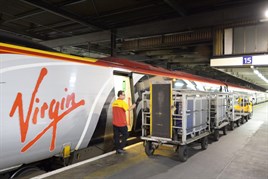On the day RAIL met Bytheway, VT had yet to learn if it would gain approval to serve Blackpool and Shrewsbury, but he was preparing for it anyway.
“Wolverhampton crews will drive to Shrewsbury, and Preston to Blackpool,” he said, adding that drivers were already route learning. (The Office of Rail Regulation gave permission for these trains on September 22, RAIL 758).
A Train Manager based at London Euston will go to Preston, Liverpool and Manchester, as well as Birmingham. Euston is the biggest base for staff (25% of VT’s staff are based there), while there are depots at Holyhead, Liverpool, Wolverhampton and Glasgow as well as Preston and London.
Bytheway says the demographic of VT staff is wide-ranging, and that there are differences to staff attitudes and longevity depending on location. For example, there is a higher turnover at Euston for catering, but depending on where you head in the North, the jobs are viewed as good.
The Holyhead depot is seen as a good place to work in the town, he says, adding: “Carlisle is seen as a good job, too - you get that experience.”
There is also longevity on the railway, which tends to be the case with any operator. Says Bytheway: “We have had staff members that have been on the railway for 40 years.”
Bytheway’s team is small, considering the number of VT staff they have to deal with. Communication is vital, and is done through phones and emails. Service Managers, Drivers and Train Managers have BlackBerrys to ensure this happens.
He himself has been on the railway since 1997. He started at Manchester Piccadilly as a roster clerk, having previously been a postman and then a civil servant.
On the day of RAIL’s visit, Molly Payne was VT’s engagement and support manager, although her role has since changed. She meets RAIL on the 1130 London Euston to Glasgow Central, a train she describes as a “flagship” for VT.
“We did an initiative by using chefs to arrange certain foods.,” she says. “It is all freshly prepared for this. We rotate the menus. We have four that we use, and we like to change them four times a year.”
She reveals that a celebrity chef will be working with the operator in December on a special menu, most likely on a Class 221 Super Voyager.
“Retail is vital for VT,” she says. “We have to understand how we work, and how DHL works, too.” DHL is the firm’s contractor, ensuring that the trains are properly stocked before each departure.
“Passenger figures are rising, and we have to make sure they are catered for.”
Also on the 1130 is VT’s Driver Depot Manager Nick Westcott, who is based at Euston and one of six DDMs working for VT. He says there are 130 drivers based at Euston and 93 at Preston. Bytheway says it takes 12 months for drivers to be trained.
Westcott is fairly new to VT, having joined from TransPennine Express in February. He started on a FirstGroup graduate scheme in Devon, and then worked for First Capital Connect at King’s Cross before moving to TPE at Manchester Piccadilly.
His job is to ensure the drivers have competency, and to help with the rosters. He doesn’t actually drive himself, but is qualified to do so, and says the drivers are employed more for their knowledge than for their skills.
In the cab of 390104 north of Oxenholme, he tells RAIL that VT drivers will drive to the train’s schedule, rather than arrive early. This actually improves the quality of the ride for passengers, he explains. Edinburgh-based driver David Dansky, who is at the controls of the Pendolino, agrees.
VT Customer Experience Manager Stuart Davison joins the 1130 Euston to Glasgow at his Preston base. A rising star, according to the firm, his job entails looking after passenger needs north of Preston.
“I look after the Anglo-Scottish trains and the frontline teams,” he says.
“I think the challenges are the number of people travelling these days. This train is busy, and everyone wants a seat. We have to think on our feet.
“The demand profile is high. There is capacity north of Preston. There is a lot of leisure and family travel. We get those travelling to Edinburgh and the Lakes. I think this summer there has been a big change in people going north. The Commonwealth Games in Glasgow had a massive impact.”
Davison notes: “It is quite lucky that they are with us for some time. It allows us to engage with them, and discover their needs. We train some staff to look for things in the cities that passengers want.”
He says of the on-board staff that “they are empowered to not be restricted”, explaining: “It allows a ‘can do’ attitude. It is the right thing to do. Our leisure travellers go once, twice by rail. We can increase that to three or four times. We want to showcase what staff are doing.”
On travelling with VT, he says: “You expect the best, you should demand the best. WiFi is a prime example.” He acknowledges that VT’s offering is not great, but pledges that will change in the new VT franchise, as it is a commitment.
Davison says the company is carrying out a lot of external recruiting. “The brand value has changed. We have invested a lot in people, and it attracts people.” He himself was attracted to VT 16 years ago - previously he was a fitness instructor.
Social media is key, he says. “What better way to get our message out there?”
Indeed. VT’s Twitter feed is the most followed of any railway company in the world. On September 4 it had 133,757 followers, but by September 30 that had risen to 139,000.
Richard McCarthy, a RAIL subscriber since he was six, is in charge of this: “I deal with the day to day tweets. We do 12-hour shifts, and are connected to the communications team. We are based in the control room at Birmingham.
“We have an overnight cult following. VT is one of the first to do 24/7 feeds. People interact with it. For example, someone will tweet and say that their taxi isn’t there, and people will tweet other firms.”
He says Friday afternoons tend to be the busiest - especially overnight and the following morning. But it’s not too bad in terms of the content. It’s not drunks, as one may expect.
McCarthy has even stopped a train before, through Twitter. “A guy tweeted that he thought there was a problem. So I went to Alstom and they said yes, that didn’t seem right, so we stopped the train.
“We appreciated that the tweet was happening, and passengers felt that they could engage in that way.”
McCarthy has always wanted to work on the railways, but as a driver, although that was not possible because of vision issues.
“I sort of fell into this role. I trained to do coastal defence work. I graduated into a recession, and talked myself onto a course at Centro and Virgin. I then nagged and talked into an apprenticeship, and the rest is history.”
The right people… in the right place… at the right time. And tomorrow, over 22 hours and more than 1,300 miles, and for hundreds of other trains, these VT staff will make it all happen again.
- This feature was originally published in RAIL 759, on 15 October 2014















Login to comment
Comments
No comments have been made yet.